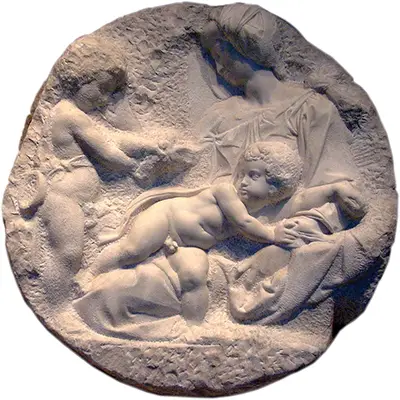Whilst holding an exceptional collection of art and antiquities across the nation, this is actually the only marble sculpture from Michelangelo to be found within a UK collection. It therefore holds great significance to this country, as well as to all those interested in the artist. In previous centuries there are many examples of where artworks would be named after their owner, particularly when several similar pieces exist. In this case, the sculpture was commissioned by a wealthy merchant who specialised in cloth, by the name of Taddeo Taddei. He was also believed to be a keen follower of the arts and so decided to call on Michelangelo's services for this piece. The Tondo part of the name, of course, refers to the round nature of the base, on which the main sculptured figures are placed. Whilst we don't see tondos much today, there were reasonably common within more traditional art movements, such as the Italian Renaissance.
This tondo was also originally known by the more descriptive title of The Virgin and Child with the Infant St John. Naturally, religion played a huge role in the work of Michelangelo, just as it did most artists within his community at the time. He finished the project in 1504-1505 but it would be a long journey before it would end up in the collection of the Royal Academy of Arts in London, UK. Sadly, in recent years, the Academy has been reported to have been considering the option of selling the piece in order to avoid significant job losses at the institution, mainly caused by the Covid-19 outbreak of 2020. The Director at the time dismissed these reports, however, and promised to protect the collection for future generations to enjoy. Such moves, even in difficult times would tend to lose favour with the public and also solve short term problems but damage the long term viability of the venue. To have the only Michelangelo sculpture within the UK under your ownership, that would be a big claim to sacrifice. There may also have been an element of creating headlines in order to draw attention to the predicament of the arts industry, without necessarily any actual intention of ever selling this beautiful piece.
We do know that in the following year after this piece was unveiled, Michelangelo himself was described as Italy's greatest artist. At this point he was still only 31 years of age and therefore competing against many much more experienced and connected colleagues at that time. Perhaps it was this tondo that helped to establish this rise to fame. The final sculpture was loved by its patron, who kept it in his home until the early 19th century, passing through many generations of his family. We do know that Michelangelo would have to leave Florence in order to start work on Pope Julius II's tomb and this meant having to stop work on this piece. Despite that, it was still well received, despite never being completely finished. He may also have been short on creative spark towards the end of the project too, which is a problem many artists have had over the centuries. Within the sculpture itself we find an infant St John the Baptist on the left, holding what appears to be his baptismal bowl, which is an item normally used to help identify him within artistic depictions. There is also a goldfinch being handed to the young Christ, who appears cautious about this gift. This may have been a playful or fearful reaction, we are unsure.



